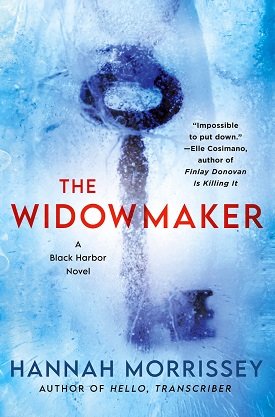Q&A: Christine Mangan, Author of TANGERINE
Ecco; March 27, 2018
I’m absolutely thrilled to welcome to CBTB today the author of one of the most exceptional debuts I’ve read in ages - and maybe ever. Christine Mangan is making her entrance into the literary world in a big way—not only has TANGERINE already received incredible reviews (find my rave here!), it’s also already been optioned for film by George Clooney’s Smokehouse Pictures. In this stunning examination of the intricacies of female friendship, Mangan sets a tense, almost claustrophobic encounter against the backdrop of 1950’s Morocco. TANGERINE is a story humming with interpersonal tension and simmering with the heat of its locale; this is truly an outstanding first novel - in fact, I’d call it outstanding even if the author had already had a seasoned career. The fact that this is Mangan’s first book is just another impressive facet of a story that more than stands on its own two feet, from pacing to character development to scene-setting and more. I highly recommend TANGERINE for fans of Patricia Highsmith, Gillian Flynn, and Alfred Hitchcock—and yes, these are lofty comparisons to make, but this book delivers.
You can find my full review of TANGERINE here. Safe to say, this one goes on my “highly-recommended” list! I’m delighted to welcome Christine Mangan to CBTB to celebrate today’s release of TANGERINE - and to discuss some of my most pressing questions about her exceptional debut.
About TANGERINE:
The last person Alice Shipley expected to see since arriving in Tangier with her new husband was Lucy Mason. After the accident at Bennington, the two friends—once inseparable roommates—haven’t spoken in over a year. But there Lucy was, trying to make things right and return to their old rhythms. Perhaps Alice should be happy. She has not adjusted to life in Morocco, too afraid to venture out into the bustling medinas and oppressive heat. Lucy—always fearless and independent—helps Alice emerge from her flat and explore the country.
But soon a familiar feeling starts to overtake Alice—she feels controlled and stifled by Lucy at every turn. Then Alice’s husband, John, goes missing, and Alice starts to question everything around her: her relationship with her enigmatic friend, her decision to ever come to Tangier, and her very own state of mind.
Author Q&A: Christine Mangan
Crime by the Book: First things first, thank you so much for taking the time to answer a few of my questions about TANGERINE! I absolutely loved your book - it just blew me away. In your own words, can you tell us a little bit about TANGERINE?
Christine Mangan: Thank you so much! Tangerine is the story of two friends and former college roommates, Lucy and Alice, who are reunited in 1950s Morocco. It’s a story about female friendship, about loss, about being an outsider—and it’s also a bit of a psychological thriller as well.
CBTB: If you had to describe TANGERINE in three adjectives, which would you choose?
CM: Sweltering, Claustrophobic, Unreliable.
CBTB: One of the biggest instant-draw factors about TANGERINE is its vivid, exotic locale: Morocco in the 1950’s. You do an absolutely stellar job bringing this setting to life - Morocco actually begins to feel like another character in the book, and I loved watching your main (human) characters interact with it. Why set your story against this backdrop?
CM: It was actually the city that inspired the novel. I visited Tangier in 2015 and while there, I was struck by how absolutely different it was from any other place I had ever been before. It’s a city that encourages such strong reactions from people—some find it too overwhelming and chaotic and others really take to the bustling atmosphere. While I was there, I found myself starting to think of how that relationship might be explored on the page.
In terms of the timeframe, I was initially drawn to it because of the literary associations with Tangier, as a number of artists and, in particular, writers, passed through the port city during that time. And then, as I started to do a bit more research, I began to realize the importance of that particular moment in history to Tangier, as the city was moving towards independence from its protectorate. There was, then, this feeling of revolution sweeping through all of Morocco, and for my characters, Lucy and Alice, I thought that this would particularly resonate, because they are, after all, women questioning their own identity and autonomy in the 1950s.
CBTB: Against the story’s vibrant backdrop, you set a really tense, almost claustrophobic story of two women caught in a dysfunctional (and possibly dangerous) friendship. How did you first “meet” these two characters? What interested you about each woman enough to make you want to write about them in as much detail as you do?
CM: I’ve always been drawn to stories about female friendship—particularly those made in our formative years. I think there is something so unique about them, and about that time, where everything feels so heightened and intense. I knew right away that I wanted to write a story about two women and their relationship, and, picking up from my previous answer about Tangier, I was inspired by the contrasting response that the city draws from people. And so, in many ways, Lucy and Alice began as that—Lucy is the one who is ready to jump in and experience the city, while Alice is frightened by the strangeness of the place, by the possibility of being an outsider, which furthers isolates her from everyone in her life.
As I began fleshing them out, what interested me most about these two women was the potential to write them in a way that could neither be labeled as good or bad, innocent or evil. This was ultimately the reason I decided to write from alternating points of view between Lucy and Alice, wanting to show the culpability of each character in the demise of their relationship, so that you can blame both of them, but you can also feel for both of them as well.
CBTB: One of the most common early comparisons I’ve seen made about TANGERINE likens it to the work of Patricia Highsmith. Was Highsmith’s work an intentional source of inspiration for your own?
CM: I do love the stories of Patricia Highsmith—although I have to confess that I have never actually read her work, only see it on the screen in The Talented Mr. Ripley and The Two Faces of January. I’ve always been drawn to those films and ones in a similar vein like Trap for Cinderella or The Lady Vanishes or A Bigger Splash. But in the end, I never sat down to intentionally write a female version of Tom Ripley, however it might be interpreted on the page.
CBTB: Without spoiling anything, I need to ask you about this book’s ending! TANGERINE begins - and ends - with the kind of scene that can only be called jaw-dropping. Again, no spoilers here, but did you have an idea of how you wanted the story to end from the outset of your writing process? Or did it develop over time?
CM: I did have the basic idea—but the details took a bit of working out through various drafts. The one thing I was certain of was the ultimate ending for Lucy and Alice.
CBTB: Given the impeccable quality of this read, it’s hard to believe, but TANGERINE is actually your debut! (Congratulations!) Readers might not know that you also have your PhD in English, with a focus on 18th-century Gothic literature. I’m so curious - and please feel free to say no if this is totally off-base - but were there any elements of the works you studied for your PhD that you hoped to incorporate into your own debut novel?
CM: Yes, absolutely. I had only just submitted my PhD thesis a few months before writing Tangerine, so Gothic literature was very much on my mind when I wrote this novel. All Gothic tales have such a strong sense of place—whether it’s Thornfield in Jane Eyre, Manderley in Rebecca—and that was something that I wanted to create in the depiction of Tangier, as the streets of the city can be just as frightening, just as threatening, just as confining, as any structure with walls.
It also influenced the creation of Lucy and Alice. I’m such a huge fan of Jane Eyre and I’ve always loved the idea of Bertha as Jane’s dark double, that side of Jane which is unrepressed, unfettered. And so, I wanted to write the relationship between Alice and Lucy in a similar vein. For example, even though Alice knows that she has doubts about John, about her marriage and life in Tangier, it takes Lucy showing up on her doorstep to really address those issues. And while Alice certainly doesn’t wish bad things to happen to him—I’m trying to word this so as to avoid spoilers—she doesn’t necessarily want to be with him. So, Lucy, at times, acts out Alice’s true feelings—but in a much more exaggerated, Gothic fashion.
CBTB: Do you have any particular writing rituals or requirements?
CM: I tend to hand write quite a bit in the beginning. I carry multiple journals around with me and I just write as much as possible before finally putting it into a word document. I tend to think better when I’m not in front of a computer.
CBTB: When you’re not writing, what kind of books do you enjoy reading? Can you share a few books with us that you’ve recently read and loved?
CM: I love Gothic novels, psychological thrillers, YA fiction—really, I read everything and anything! More recently, some of my favorites that I’ve read over the past few months include The Perfect Nanny by Leila Slimani, Mrs. Caliban by Rachel Ingalls, and Uprooted by Naomi Novik.
CBTB: What are you working on next? Can readers look forward to another psychological suspense novel from you soon? (I hope so!)
CM: I’m not sure at the moment—only time will tell!
Many, many thanks to Christine for taking the time to answer my questions, and to her publisher for facilitating this interview! TANGERINE is on sale today, March 27th, from Ecco.
Book Details:
Hardcover: 320 pages
Publisher: Ecco (March 27, 2018)
Language: English
ISBN-10: 0062686666
ISBN-13: 978-0062686664
Crime by the Book is a participant in the Amazon Services LLC Associates Program, an affiliate advertising program designed to provide a means for sites to earn advertising fees by advertising and linking to Amazon.com. This in no way affects my opinion of the above book.














Home ownership feel like a distant dream? Zillow listings have you convinced you’ll be renting for the rest of your life? The woman at the heart of Carissa Orlando’s debut The September House feels your pain—and she’s prepared to put up with a lot if it means she and her husband can finally have a place to call their own. In this case, that might just mean living in a house that’s haunted. Playful and irreverent, spine-tingling and spooky, The September House puts a fresh spin on the classic haunted house story, delivering an immersive tale about the secrets lurking within one building’s walls, and within the lives of its inhabitants.